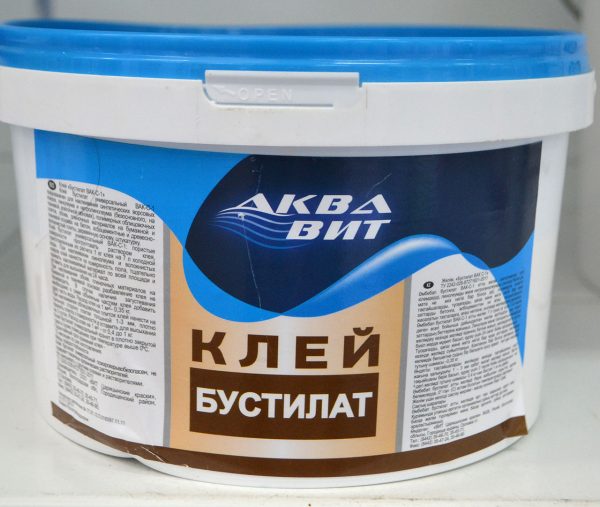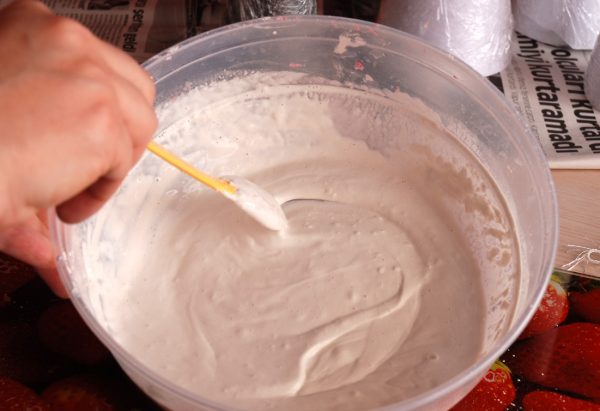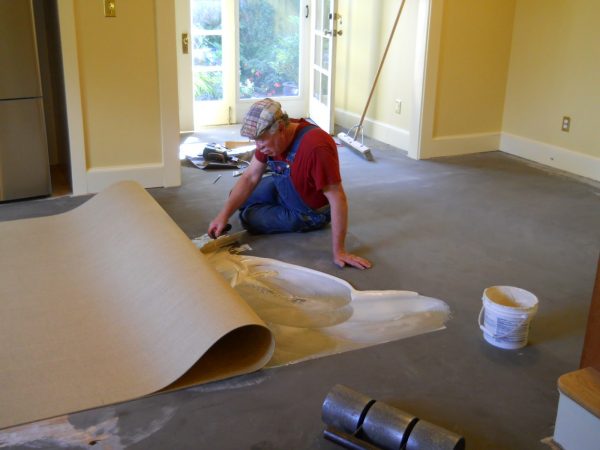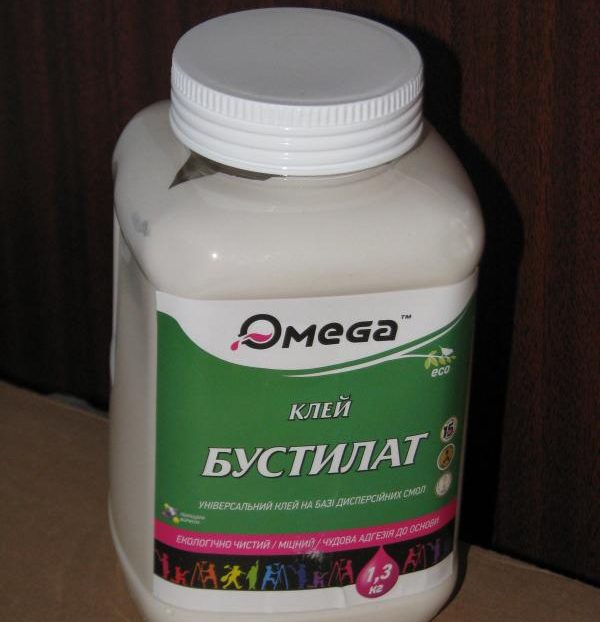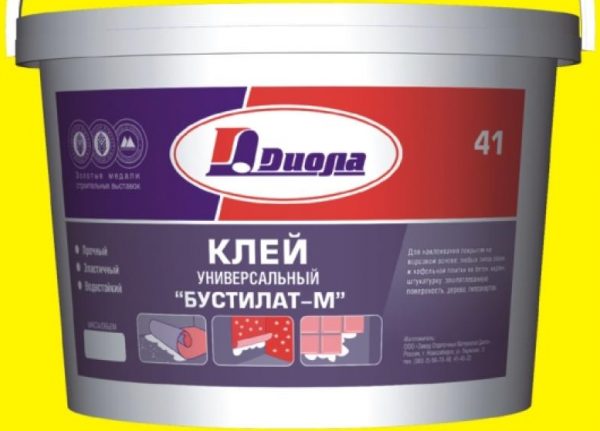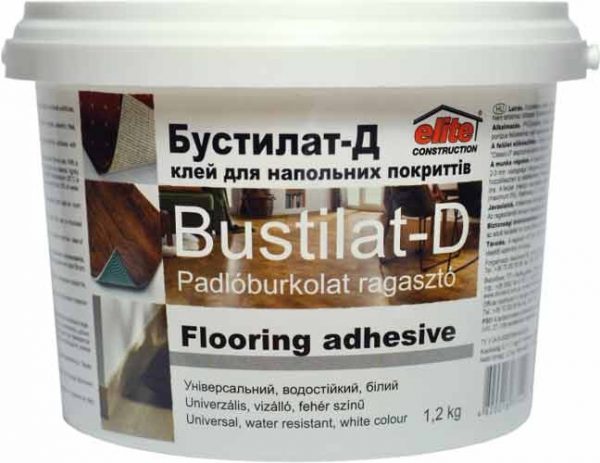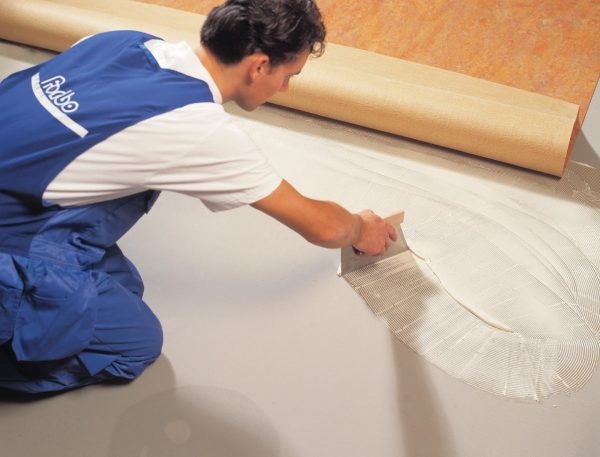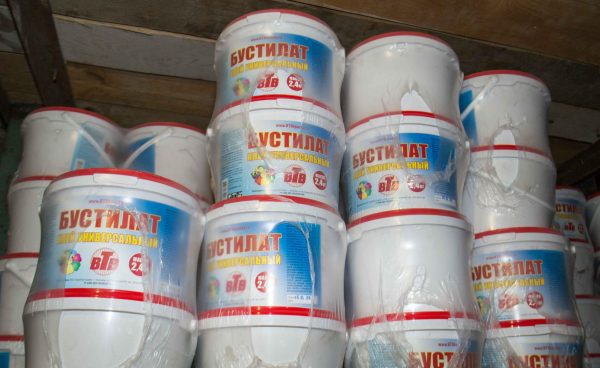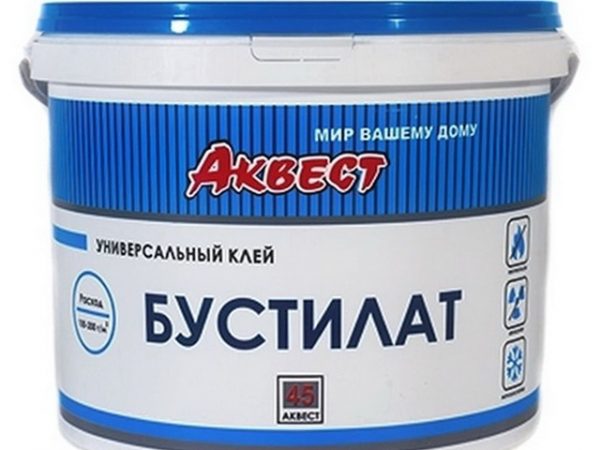Bustilat glue - an artificial adhesive that has been widely used in everyday life, repair. It is perfect for linoleum and wallpaper, can also reliably attach tiles, wood, carpets. Glue was developed back in the 60s of the last century, but thanks to improved composition and the release of new varieties, it has not lost popularity.
- General information about Bustilat
- Composition
- Technical characteristics of the adhesive
- Scopes of "Bustilat"
- Types of Bustilate
- Omega Bustilate
- Bustilat Suite
- Bustilat-M
- Bustilat-N
- Bustilat-D Super
- Advantages and disadvantages
- Adhesive Tips
- Surface preparation
- Recommendations for use
- Floor Coating
- Laying tiles
- Wallpapering
- Remove the old glue
- Precautions, packaging and storage
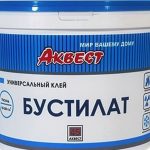
General information about Bustilat
Bustilat is a universal construction adhesive of synthetic origin. Good adhesion indicators and harmlessness to health are the main qualities that make it suitable for use inside human housing. The glue cannot be operated on the street, but indoors it is used to decorate walls, floors, and ceilings, it allows you to reliably fix decor elements and not drill extra holes. Bustilat is an invention of Russian scientists from the Mosstroy Research Institute, but now it is produced by different companies:
- "Bright colors";
- VGT;
- "Expert";
- "Akvest";
- "Roda Color";
- "Satellite";
- Aquit;
- "Diola", etc.
The most popular is the glue "Lacra M 20" from the manufacturer "Lacra", which can be found in any hardware store. Quality glue always has a certificate of conformity. Many companies produce glue in accordance with GOST 24064-80, but its release is also allowed according to specially developed specifications.
to contents ↑Composition
The adhesive is based on latex, an artificial rubber stabilized by surface-active emulsifiers. Also, to thicken the composition, CMC (carboxymethyl cellulose) and chalk are added, water acts as a solvent. To ensure preservation during the expiration date, preservatives are also introduced into the composition. Solvents and other harmful volatile substances in Bustilate are absent.
Technical characteristics of the adhesive
In appearance, the glue is a creamy viscous mass of grayish-white color, without a pungent odor, not including lumps. The density of the composition is 1.27 kg / l. The glue is not flammable, not combustible, since it does not include alcohol. After drying, it becomes transparent, does not form yellow spots even on the thinnest materials. Here are the other specifications for Bustilat:
- fraction of solids - 50-52%;
- viscosity - 34 s (according to the viscometer “standard navy mug”);
- connection strength - 40 kgf / sq. cm;
- consumption per m2 - 0.4-0.6 kg for continuous application (varies depending on the type of base);
- the final drying time is 24 hours (at a temperature of about +20 degrees).
Since the glue contains water, it freezes in the cold and can expand. In this regard, the external use of the drug is not recommended, although it is permissible in the warm season. Also, you can not use glue in unheated rooms.The cost of Bustilat domestic production is usually much lower than that of imported analogues, although the properties are approximately the same.
to contents ↑Scopes of "Bustilat"
Glue is used for arranging various coatings inside the house, if strong fixing of finishing materials is required. Due to the elasticity, the adhesive joint will serve for a long time, because it is not subject to destruction by vibrations, vibration, and mechanical stresses. The tool is perfect for such bases:
- concrete;
- a tree;
- brick;
- Fiberboard, particleboard;
- stone;
- plaster.
“Bustilatom” glues wallpapers of various types, including the heaviest. It is suitable for fixing carpet, other pile coatings, linoleum with a fabric and felt base. The glue is suitable for fixing polymer and ceramic tiles, panels, stucco moldings, moldings and other decor, wood trim. Also, the glue is useful for working with asbestos-cement plates. Another tool is added during various repairs to cement, which will increase the strength of the mortar or screed.
to contents ↑Types of Bustilate
The adhesive composition, which was originally developed, has undergone a number of changes. Now the glue is available in various versions that differ in physical properties and functionality.
Omega Bustilate
This tool is intended for gluing well absorbent materials on walls, floors, including for floor coverings with a base of felt, pile, textiles. Using "Omega Bustilate" you can attach fabric wallpaper, carpet. No less high-quality wall decoration will be paper wallpaper, photo wallpaper. It is permissible to use means for fixing wooden coatings, but on metal and PVC it is better not to use it, these materials have low absorbency.
to contents ↑Bustilat Suite
The glue is suitable for joining various polymers, PVC films, linoleum, and tile. He reliably fastens the specified materials to surfaces from concrete, a tree, to plastered walls.
Bustilat-M
The product is the most famous type of "Bustilatov", suitable for most materials of walls, floors, ceilings, partitions and ceilings. The best adhesion is to finish with concrete, wood, brickwork, plaster and putty, drywall. Thick "Bustilat-M" can be used for laying tiles, linoleum, wallpaper stickers. After dilution with water, the product turns into a high-quality primer.
to contents ↑Bustilat-N
This glue has the highest adhesion among the "brothers." It can attach various materials even to smooth substrates, including those painted with oil paint. Due to its high moisture resistance, the adhesive is widely used as liquid waterproofing. They can also be attached with a complex finish:
- cullets;
- heavy vinyl wallpapers;
- linoleum without a base;
- synthetic carpets.
to contents ↑Due to its high elasticity, the product is suitable even for deformable substrates, over time it will not collapse, since it does not shrink.
Bustilat-D Super
This is another reinforced composition designed for bonding smooth polymeric materials. The tool is suitable for dense and heavy roll wallpaper, baseless vinyl linoleum. Special additives are added to the glue that prevent the appearance of fungus and mold.
to contents ↑Advantages and disadvantages
The tool has a huge number of advantages, due to which it remains "afloat", despite the presence of more modern analogues. Ecological cleanliness is one of the important advantages, therefore it can be used even in child care facilities and hospitals. Other advantages of glue:
- profitability - low consumption, low price;
- short term of full hardening (day);
- sufficient time to adjust the position of the elements;
- lack of spots, sagging after drying;
- incombustibility, fire safety;
- excellent adhesion, strength of the finished compound.
There are also disadvantages. Compared to expensive multicomponent adhesives, the service life of Bustilat is lower. You can not use it in an unheated room, on the street, because its frost resistance is at a low level.
to contents ↑
Adhesive Tips
You must use the tool strictly in accordance with the instructions, which are written simply, clearly and do not require special knowledge and skills. Before applying the glue, it must be mixed well, since precipitation may occur due to long storage. It is permissible to apply the composition with any tool at the request of the master: roller, brush, putty knife, cotton swab.
Surface preparation
The base must be cleaned of dirt, dust, remove traces of the old coating and glue. The walls, floor, ceiling before finishing are leveled, putty, sanded, and then primed. Too porous surfaces are treated with special deep penetration primer. If the glue does not contain antifungal additives, their additional application is recommended.
Recommendations for use
Before starting work, you need to ventilate the room well. It is undesirable to use “Bustilat” in rooms with high humidity: despite moisture resistance, with prolonged exposure to steam, the adhesion of the adhesive decreases. If the product is thickened, it can be completely diluted with water (up to 5% of the total).
Floor Coating
To stick linoleum, carpet glue should be applied only to the floor. With a spatula, a thin adhesive layer is made (up to 3 cm), then a floor covering is laid, pre-prepared and straightened, cut to the size of the room. The material must be well pressed to the floor, rolling literally every centimeter with a roller.
to contents ↑The room can be operated after 72 hours, during this period the glue will completely dry and gain full adhesion. There is another option for finishing the floor - add cement to the “Bustilat” (1: 1). The most durable, hard coatings can be laid on such a solution.
Laying tiles
Laying tile on the wall can also be carried out using this glue. On the reverse side of the tiles with a toothed spatula, a layer of 2-3 mm is applied, the elements are pressed against the wall, aligned. After allowing the surface to dry for 2 days (before the start of active use, for example, before hanging the hooks).
Wallpapering
A recently printed packaging of glue is used immediately, without dilution. Too thickened agent should be diluted with water until a homogeneous mass resembling sour cream is obtained. Next, the adhesive is applied to the wall or wallpaper (depending on the instructions for a particular type of wallpaper) with a brush, roller. After 10 minutes, apply the canvas to the wall, level it, carefully smooth it with a rag, rubber roller, plastic spatula. You can open the windows in the room only after a day.
to contents ↑Remove the old glue
If you have to remove the coating that was previously glued to the Bustilate, it is important to completely free the surface from its residues. The cured adhesive does not dissolve in water, so there is no point in soaking it. The easiest way to scrape it with a sharp spatula, scraper, knife. The remnants of the product are well separated by a grinder, on which a metal brush head is fixed.
to contents ↑You can also try removing the glue by heating. First, a cloth is moistened with water and applied to the contaminated area, then the place is well heated with a hairdryer, iron. Hot glue is easier to clean, but the process will take quite a while.
Precautions, packaging and storage
The glue does not pose a threat to life, its composition is safe, but some tips must be followed when working. Work should be done with gloves, and after installation is complete, ventilate the room (with the exception of wallpapering, in this case drafts are prohibited). If glue gets into your eyes, rinse them with warm water and consult a doctor.
"Bustilat" is available in plastic cans, pails of 1-3 kg, as well as in large containers (5-18 kg).
Glue should be stored in closed packaging, protected from elevated temperatures, access to sunlight. During transportation, short-term freezing up to 5 times is permissible. After thawing in a natural way, the product retains its properties. Duration of storage at + 5 ... + 20 degrees is 12 months.

